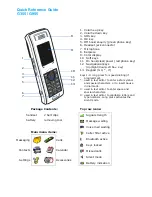
480
C
HAPTER
17: Q
O
S
AND
RSVP
■
Controls
— Define the following parameters to a
ssign rate limits and
priorities to the packets that are associated with one or more
classifiers:
■
Rate limit
— Limits the amount of input bandwidth used by
incoming classified traffic (optionally, on a per-port basis). When
you define a control, you can specify one of three rate limits:
none
(no rate limit),
receivePort
(a separate limit on each specified
receive port),
aggregate
(limits on groups of receive ports)
■
Service levels
—
Specify a transmit priority and map to a specific
transmit queue. If you specify receivePort or aggregate for a rate
limit, you can assign a service level of
high
,
best
, or
low
to both
conforming packets (packets that are below the rate-limit
parameters) and nonconforming excess packets (excess packets
that exceed the rate-limit parameters). If you set the rate limit to
none, you can specify a service level of high, best, low, or
drop
for
conforming classified packets.
Drop causes the system to drop all packets on all ports associated with
the control and its classifier. If you want to drop conforming packets for
only a subset of ports, specify the receivePort or aggregate rate limit, set
the rate limit to 0, and specify the group of ports.
■
Loss-eligible status
— Loss-eligible packets
are conforming
packets that are discarded instead of queued when transmit
queues back up beyond a threshold. You can specify whether
conforming packets (as well as nonconforming excess packets) are
loss eligible when you define a control. Marking packets loss
eligible is useful for an intelligent discard of traffic in a congestion
situation. When the system is congested, you can decide which
traffic can be discarded and mark that traffic loss eligible.
■
Burst size
— The maximum amount of data that you can transmit
at the line rate before the transmission is policed. This value
accommodates variations in speeds and allows you to occasionally
exceed the configured rate.
■
TCP drop control
— TCP drop control lets you create QoS Flow
Classifiers that allow traffic going from “source” IP addresses to
“destination” IP addresses to be dropped or otherwise controlled
using one-way TCP flow filtering. This control can only be used for
flow classifiers that use the TCP/IP protocol.
Summary of Contents for CoreBuilder 3500
Page 44: ...44 CHAPTER 2 MANAGEMENT ACCESS ...
Page 58: ...58 CHAPTER 3 SYSTEM PARAMETERS ...
Page 86: ...86 CHAPTER 5 ETHERNET ...
Page 112: ...112 CHAPTER 6 FIBER DISTRIBUTED DATA INTERFACE FDDI ...
Page 208: ...208 CHAPTER 9 VIRTUAL LANS ...
Page 256: ...256 CHAPTER 10 PACKET FILTERING ...
Page 330: ...330 CHAPTER 12 VIRTUAL ROUTER REDUNDANCY PROTOCOL VRRP ...
Page 356: ...356 CHAPTER 13 IP MULTICAST ROUTING ...
Page 418: ...418 CHAPTER 14 OPEN SHORTEST PATH FIRST OSPF ...
Page 519: ...RSVP 519 Figure 94 Sample RSVP Configuration Source station End stations Routers ...
Page 566: ...566 CHAPTER 18 DEVICE MONITORING ...
Page 572: ...572 APPENDIX A TECHNICAL SUPPORT ...
Page 592: ...592 INDEX ...
















































